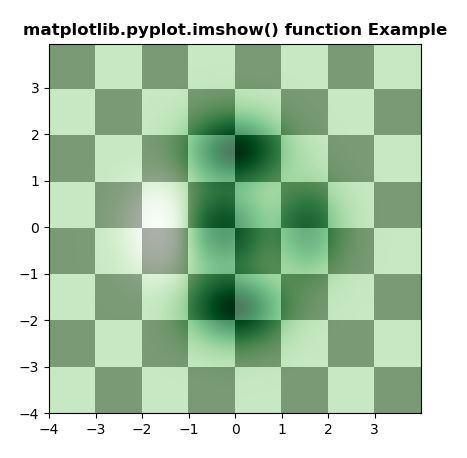matplotlib.pyplot.imshow() in Python
Last Updated :
22 Apr, 2020
Matplotlib is a library in Python and it is numerical – mathematical extension for NumPy library. Pyplot is a state-based interface to a Matplotlib module which provides a MATLAB-like interface.
matplotlib.pyplot.imshow() Function:
The imshow() function in pyplot module of matplotlib library is used to display data as an image; i.e. on a 2D regular raster.
Syntax: matplotlib.pyplot.imshow(X, cmap=None, norm=None, aspect=None, interpolation=None, alpha=None, vmin=None, vmax=None, origin=None, extent=None, shape=, filternorm=1, filterrad=4.0, imlim=, resample=None, url=None, \*, data=None, \*\*kwargs)
Parameters: This method accept the following parameters that are described below:
- X: This parameter is the data of the image.
- cmap : This parameter is a colormap instance or registered colormap name.
- norm : This parameter is the Normalize instance scales the data values to the canonical colormap range [0, 1] for mapping to colors
- vmin, vmax : These parameter are optional in nature and they are colorbar range.
- alpha : This parameter is a intensity of the color.
- aspect : This parameter is used to controls the aspect ratio of the axes.
- interpolation : This parameter is the interpolation method which used to display an image.
- origin : This parameter is used to place the [0, 0] index of the array in the upper left or lower left corner of the axes.
- resample : This parameter is the method which is used for resembling.
- extent : This parameter is the bounding box in data coordinates.
- filternorm : This parameter is used for the antigrain image resize filter.
- filterrad : This parameter is the filter radius for filters that have a radius parameter.
- url : This parameter sets the url of the created AxesImage.
Returns: This returns the following:
- image : This returns the AxesImage
Below examples illustrate the matplotlib.pyplot.imshow() function in matplotlib.pyplot:
Example #1:
import matplotlib.pyplot as plt
import numpy as np
from matplotlib.colors import LogNorm
dx, dy = 0.015, 0.05
y, x = np.mgrid[slice(-4, 4 + dy, dy),
slice(-4, 4 + dx, dx)]
z = (1 - x / 3. + x ** 5 + y ** 5) * np.exp(-x ** 2 - y ** 2)
z = z[:-1, :-1]
z_min, z_max = -np.abs(z).max(), np.abs(z).max()
c = plt.imshow(z, cmap ='Greens', vmin = z_min, vmax = z_max,
extent =[x.min(), x.max(), y.min(), y.max()],
interpolation ='nearest', origin ='lower')
plt.colorbar(c)
plt.title('matplotlib.pyplot.imshow() function Example',
fontweight ="bold")
plt.show()
|
Output:

Example #2:
import matplotlib.pyplot as plt
import numpy as np
from matplotlib.colors import LogNorm
dx, dy = 0.015, 0.05
x = np.arange(-4.0, 4.0, dx)
y = np.arange(-4.0, 4.0, dy)
X, Y = np.meshgrid(x, y)
extent = np.min(x), np.max(x), np.min(y), np.max(y)
Z1 = np.add.outer(range(8), range(8)) % 2
plt.imshow(Z1, cmap ="binary_r", interpolation ='nearest',
extent = extent, alpha = 1)
def geeks(x, y):
return (1 - x / 2 + x**5 + y**6) * np.exp(-(x**2 + y**2))
Z2 = geeks(X, Y)
plt.imshow(Z2, cmap ="Greens", alpha = 0.7,
interpolation ='bilinear', extent = extent)
plt.title('matplotlib.pyplot.imshow() function Example',
fontweight ="bold")
plt.show()
|
Output:

Like Article
Suggest improvement
Share your thoughts in the comments
Please Login to comment...